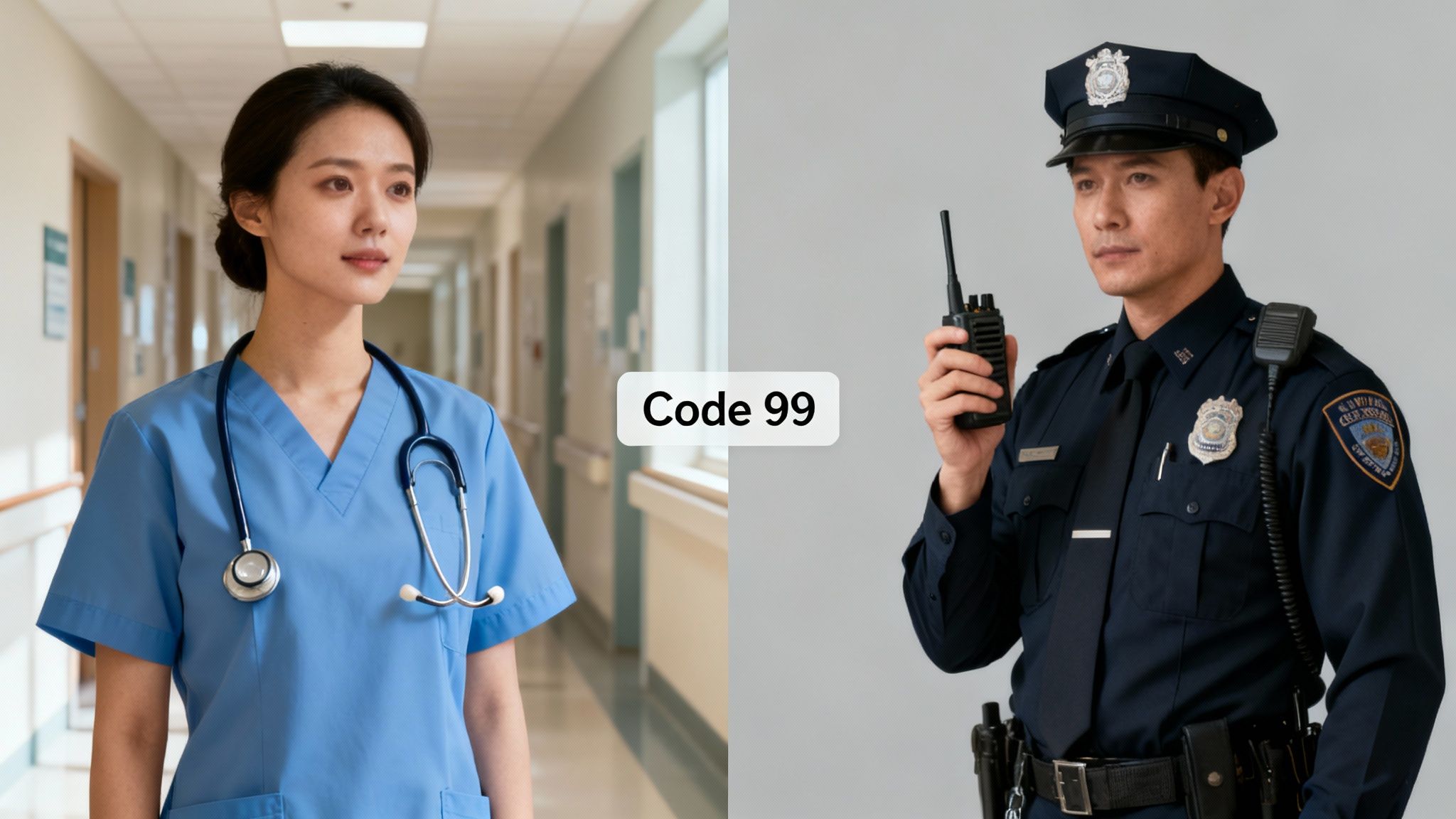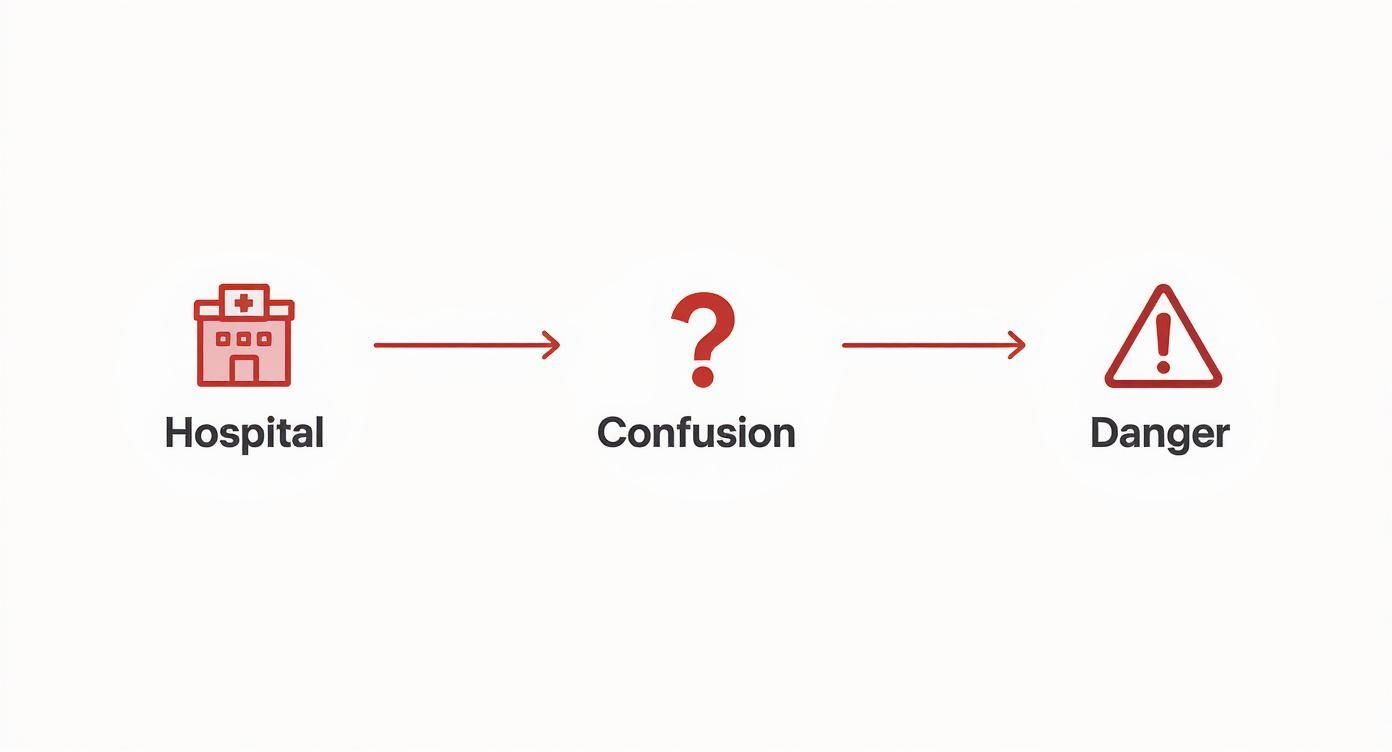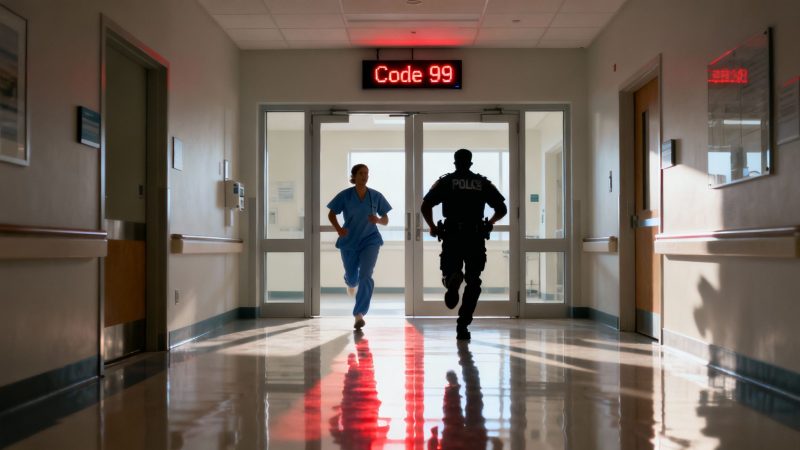What Is a Code 99? A First Responder’s Guide
When you hear "Code 99" over the radio, it's a signal for a high-stakes, all-hands-on-deck emergency. Think of it as the ultimate alarm bell for first responders. The catch? What it means depends entirely on where you are.
Understanding the Code 99 Emergency Signal

A Code 99 is one of the most serious alerts in the world of emergency communications, but its meaning is dangerously inconsistent. It’s simply not a universal signal with one single definition.
In a hospital, a Code 99 often means a patient is in severe distress but hasn't gone into full cardiac arrest yet. For law enforcement, though, that same code frequently means an officer is in immediate, life-threatening danger and needs backup—right now.
This guide will break down what a Code 99 means in the real world, walking through the different protocols for medical and law enforcement teams. Getting these distinctions right is absolutely critical for an effective—and safe—emergency response.
To put it simply, the context of a Code 99 alert changes everything. Here’s a quick breakdown of how its meaning can shift depending on the situation.
Code 99 Meanings at a Glance
| Context | Common Meaning | Primary Objective |
|---|---|---|
| Medical/Hospital | A patient is experiencing a severe medical emergency, short of full cardiac arrest (e.g., respiratory failure). | Mobilize the medical response team to prevent the patient from coding. |
| Law Enforcement | An officer is under immediate threat and requires urgent assistance. | Send all available units to the officer's location for immediate backup. |
| Fire/EMS (Field) | Can signify a major medical event, but often aligns with law enforcement needs for a high-threat scene. | Varies by agency; could be a mass casualty incident or a scene that has become unsafe for responders. |
As you can see, the same two words trigger wildly different actions based on the uniform you're wearing and where you're standing. Seconds count, and a misinterpretation can be disastrous.
Why Context Is So Critical
The specific definition of a Code 99 can vary by:
- Profession: Medical teams and police officers use the same code for vastly different events.
- Location: Protocols can change between states, cities, and even neighboring hospitals.
- Agency: Individual departments or healthcare systems set their own internal code definitions.
For instance, in the medical world, a Code 99 might be called for severe respiratory failure. Understanding what constitutes a cardiac event is key to differentiating it from a "Code Blue," which is universally cardiac arrest.
This is where modern dispatch systems can be a game-changer, offering features that provide clarity and help manage these varied responses. When lives are on the line, there’s no room for guessing games.
The Two Worlds of Code 99: Medical vs. Law Enforcement

A Code 99 alert isn't a universal signal. In fact, its meaning splits dramatically depending on where you hear it. For any first responder, knowing this distinction isn't just trivia—it’s a matter of life and death. A simple misunderstanding can waste precious seconds and send the wrong people to the wrong emergency.
Let's break down the two very different worlds of Code 99.
Code 99 in a Hospital Setting
Inside the controlled, sterile hallways of a hospital, a Code 99 usually signifies a major medical emergency. But it's not always what you think. It’s often reserved for a patient who is conscious but circling the drain—think sudden respiratory failure or a major internal bleed. The goal is immediate, aggressive intervention before the patient goes into full cardiac arrest.
This is a critical distinction from other alerts. At the Kingston Health Sciences Centre, for instance, a Code 99 is for urgent situations with a conscious patient. This separates it from a Code Blue (adult cardiac arrest) or a Code Pink (pediatric cardiac arrest). If you're curious, you can explore the various emergency codes to see how hospitals triage different crises.
The Law Enforcement Perspective
Out on the streets, a Code 99 radio call is one of the most chilling transmissions an officer can hear. It's a distress signal of the highest order.
This isn't a call for routine assistance; it's a desperate plea indicating an officer is in a life-threatening situation and requires immediate, overwhelming backup. The threat is extreme, and the stakes couldn't be higher.
When an officer calls a Code 99, it triggers an "all cars" response. All non-essential radio traffic goes silent. Every available unit in the vicinity drops what they're doing and responds, knowing their colleague's life hangs in the balance.
Why This Matters for Dispatch and Operations
Understanding this sharp divide is everything for inter-agency cooperation and smart resource management. Think about it: sending a medical team to a police standoff or dispatching police units to a non-violent medical event is a costly and dangerous mistake.
This is where proper dispatcher training and crystal-clear communication protocols become non-negotiable. By ensuring dispatchers verify the context—simply asking, "Is this medical or law enforcement?"—agencies can avoid wasting fuel, manpower, and critical response time. Ultimately, getting it right saves money, improves outcomes, and, most importantly, saves lives.
Why Emergency Codes Are Dangerously Inconsistent
It’s easy to assume that a “Code 99” means the same thing everywhere. It’s a common mistake, and a dangerous one. The hard truth is that we’re dealing with a chaotic patchwork of definitions that changes from state to state, city to city, and even between two hospitals right across the street from each other. This isn't just an inconvenience; it's a critical safety risk.
When every second counts, ambiguity is the last thing you need. This lack of a universal standard creates confusion that can delay life-saving care or put first responders in harm's way. A simple misinterpretation can send the wrong team to the wrong crisis, which is a massive waste of time and resources when they're needed most.
The Real-World Impact of Vague Codes
Just think about it for a minute. A traveling nurse, who for years has known "Code 99" to mean a major medical emergency like a cardiac arrest, hears that same alert in a new hospital. The problem? Here, it means there's a violent person on the loose. That moment of confusion could lead to a disastrously delayed or completely wrong response.
This isn't just some made-up scenario. A landmark survey of Pennsylvania healthcare facilities uncovered a startling lack of uniformity, finding over 80 different emergency codes being used. The study found more than 15 unique variations just for a combative person. "Code Yellow" could mean anything from a bomb threat to a patient fall, all depending on which hospital you were in. You can dig into the troubling findings on code inconsistency for yourself.
The core issue is that with no single, unified meaning nationwide, signals like what is a code 99 become dangerously subjective, heightening the risk of confusion during critical incidents.
An Actionable Insight That Saves Money
The most powerful, cost-saving takeaway from all this chaos is incredibly simple: never assume. For boots-on-the-ground first responders, this means you have to meticulously learn your specific organization's protocols. And when you’re working with other agencies, you always confirm what their codes mean. No exceptions.
For the folks in administration, standardizing these codes internally—and pushing for regional standardization—is a direct investment in both safety and efficiency. Clear, consistent codes cut down on remedial training, prevent expensive response errors, and ultimately save money by making sure the right people and equipment are sent out correctly the first time. It's a simple policy shift that can prevent critical errors and improve outcomes, all without a hefty price tag.
What a Code 99 Response Actually Looks Like
When a Code 99 is declared, what happens next? It’s a flurry of activity, but it’s controlled chaos, where countless hours of training and well-defined protocols take over. Let’s walk through a couple of real-world scenarios to see just how different—and precise—these responses can be.
Scenario One: Medical Emergency in a Hospital
A nurse rounds a corner and finds a patient in acute respiratory distress. The call goes out: Code 99.
Instantly, an overhead announcement echoes through the halls with the code and location. At the same time, pagers buzz to life, summoning a dedicated rapid response team. This isn't just a random assortment of staff; it's typically a critical care nurse, a respiratory therapist, and a physician who drop what they're doing, grab their kits, and race to the patient's room from all corners of the hospital.
When they arrive, the team functions like a well-oiled machine, often without needing to speak. One person is on vitals, another preps medication, while the physician leads the assessment, making split-second decisions. Their one and only goal is to stabilize the patient and stop a full-blown cardiac arrest before it happens.
Scenario Two: An Officer in Distress
Imagine a police officer, ambushed and in immediate danger, manages to get one transmission out: "Code 99." That's it.
The effect on the radio waves is immediate and absolute. All other non-critical chatter stops cold. This is known as radio silence, and it's crucial for ensuring the distressed officer's next words—if they can get them out—are heard without interference.
Every single available unit in the area instantly changes course, converging on the officer's last known location. This isn't a mad dash; it's a coordinated flood of backup. Some officers establish a perimeter to contain the threat, while a dedicated team moves in to make the rescue. The entire response is designed to be swift, overwhelming, and focused on one thing: getting their colleague out safely.
The Danger of Inconsistency
As you can see, the context is everything. But what happens when the codes themselves aren't consistent? The wide variation in emergency codes from one hospital to the next can inject dangerous confusion right when clarity is needed most.

This really drives home the point: a lack of standardization is a direct line to increased risk. Seconds of hesitation or confusion can have a massive impact on outcomes.
To paint a clearer picture of how these protocols differ, let's break them down side-by-side.
Code 99 Response Protocol Comparison
| Response Element | Hospital Protocol | Law Enforcement Protocol |
|---|---|---|
| Trigger | Patient in critical distress (e.g., severe respiratory issues, neurological event). | Officer facing an immediate, life-threatening situation (e.g., ambush, injury). |
| Initial Action | Overhead announcement and targeted paging of a specialized medical team. | Immediate radio silence; all available units dispatched to the officer's last known location. |
| Personnel | Rapid Response Team: Critical Care Nurse, Respiratory Therapist, Physician. | All nearby patrol officers, tactical units, and supervisory staff. |
| Primary Goal | Stabilize the patient and prevent cardiac or respiratory arrest. | Neutralize the threat and rescue the officer at all costs. |
| Communication | Direct, in-person communication at the patient's bedside. | Coordinated radio communication to establish a perimeter and direct the rescue team. |
This comparison shows just how tailored each response is to its environment. The core principle is the same—an all-hands, high-priority emergency—but the execution is worlds apart.
In many hospitals, a Code 99 is very specifically a non-cardiac arrest emergency that still requires a massive clinical response. For instance, a facility might use it to get all hands on deck for a medical crisis involving anyone on the property, but they'll switch to a different code entirely if the patient goes into cardiac arrest. You can dig deeper into these kinds of specific medical emergency procedures and their goals.
Managing these complex, high-stakes responses is where modern tech makes a huge difference. Having reliable first responder mobile applications in your toolkit helps cut through the noise, ensuring the right people get the right information the second it's available.
Proven Best Practices for Responding to a Code 99
When a Code 99 goes out, gut instinct takes over. But instinct alone isn't enough; it has to be sharpened by disciplined training. The real difference between a controlled response and a chaotic one comes down to solid best practices that have been drilled until they become muscle memory.
For any emergency, it all boils down to three things: speed, precision, and clear communication. These aren’t just words we throw around—they are the absolute pillars of an effective operation that keeps responders safe and saves lives.
Best Practices for Law Enforcement
When an officer is in distress, the urge to just floor it and rush in is overwhelming, but that impulse has to be controlled. This is where tactical discipline is everything.
- Avoid the Funnel: Don't just stampede toward the officer's last known location. That creates a "funnel" effect, turning responding officers into a single, massive target for a potential assailant. The first priority is to establish a perimeter to contain the threat before moving in for the rescue.
- Maintain Radio Silence: A Code 99 demands absolute radio discipline. All that unnecessary chatter can easily drown out critical updates from the officer who's in trouble or from the primary response team. Keeping the air clear allows vital intelligence to get through when it matters most.
Best Practices for Medical Teams
In a hospital setting, a Code 99 is a flat-out race against the clock, and your success is determined long before the alarm ever sounds. Preparation is everything.
A key practice that saves both money and lives is running routine 'mock codes.' These drills are what build the muscle memory needed for a seamless response, cutting down on hesitation and errors when a real emergency strikes.
On top of that, you have to ensure that emergency crash carts are always fully stocked and right where they need to be. A cart that’s missing essential supplies is a critical failure point, and it’s one that is completely preventable with simple, consistent checklists.
Finally, one of the most powerful tools any organization has costs absolutely nothing: the post-incident debrief. After every Code 99, get the team together. Talk about what went right and, just as importantly, what could be done better next time. This process is invaluable for spotting procedural flaws and refining how you'll respond in the future, turning every single incident into a chance to learn and improve.
This cycle of continuous improvement is fundamental to operational excellence. For more guidance on optimizing your team's response protocols, you can find some great resources in our support documentation for first responders.
Got Questions About Code 99?
Even after breaking it down, I know these emergency codes can still be a bit murky. Let's tackle some of the most common questions that pop up about what Code 99 really means out in the field.
Is a Code 99 the Same Thing as a Code Blue?
Nope, they're two very different alerts, especially inside a hospital.
A Code Blue is the universal signal for a cardiac arrest. Plain and simple, it means a patient's heart has stopped, and the resuscitation team needs to be there now.
A Code 99, on the other hand, is often the step before a Code Blue. It’s for a patient who is alive but in serious trouble—think severe breathing difficulty or a plummeting heart rate. The rapid response team's job is to jump in and stabilize the patient before it escalates to a full-blown cardiac arrest.
Do All Police Departments Use Code 99?
Not even close. This is a perfect example of the dangerous lack of standardization we've been talking about. While "Code 99" is a fairly common signal for an officer in immediate danger, it's far from the only one.
Depending on the agency, you'll hear different codes for the exact same life-or-death situation, like:
- Code 0 (pronounced "Code Zero")
- 10-33 (a classic 10-code for an emergency situation)
- Just plain language, like "officer down" or "officer needs help"
This is exactly why every single first responder has to be fluent in their own local protocols. There's no room for guessing when lives are on the line.
What Should a Civilian Do During a Hospital Code 99?
If you're visiting a hospital and hear "Code 99" over the intercom, the absolute best thing you can do is get out of the way. Seriously. That announcement unleashes a tidal wave of people and heavy equipment moving at top speed.
Step into a patient room, a waiting area, or any spot that's out of the main hallway. Keep the corridors and elevators clear. Every second you save them by giving them a clear path could make all the difference for the patient.
Managing these kinds of critical alerts, especially when they vary so much, demands a rock-solid system. That's where Resgrid, LLC comes in. We provide a powerful, unified platform that streamlines dispatching, messaging, and personnel tracking to make sure your team is always connected and informed, no matter what code is called. Find out more at https://resgrid.com.

